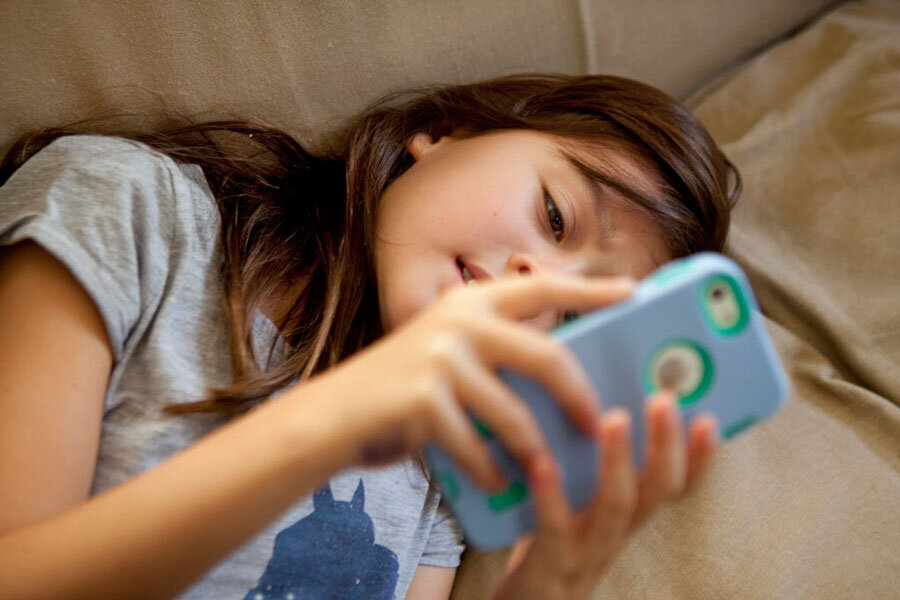Half of US teens say they're 'addicted' to smartphones. How to help?
Loading...
Ask parents trying to orchestrate a family dinner, and the exasperated answer will be immediate: Yes, the kids are addicted to their smartphones. What may be more surprising is that more than half of teenagers think they are hooked, too.
And what’s most concerning is that overuse of those too-handy devices appears to be changing the way America’s roughly 40 million teens communicate and form relationships in the wider world, experts say.
Certainly, concerns about screens and distracted teens have been around since at least the 1990s. But the ever-changing – and ever-present – nature of smartphones and social media is transforming society faster than families, or even the experts, can keep up.
“We think it’s a clarion call to this country and actually to folks around the world to take stock of how devices and technology are transforming human interaction and relationships and what we can do about that,” says James Steyer, CEO and founder of Common Sense Media, which released a new report, “Technology Addiction: Concern, Controversy and Finding Balance."
A growing body of research shows that the average six to nine hours of daily screen time consumed by tweens and teens is potentially damaging their development and family relationships – including a possible impairment of concentration and memory and a shrinking capacity for the conversational skills that develop empathy.
While there’s a fairly broad consensus about the kinds of problems caused by too much screen time, the research is pock-marked with asterisks. Researchers warn the prevalence of mobile technology in our lives is not being matched by funding to research its effects – there is practically none, they say. However, they also point to technology's upsides, and add that there are practical ways for parents to mitigate problems, especially if they take control early.
Among the standout statistics from the report's nationwide survey of more than 1,200 teens and parents:
- 50 percent of teens said they feel addicted to their devices, and 59 percent of parents said they believed their children were hooked.
- 72 percent of teens felt the need to immediately respond to texts, social networking messages, and other notifications, versus 48 percent of parents who felt that way.
- 77 percent of parents believe their child is distracted by devices and doesn’t pay attention when they’re together. This one came with an interesting kicker: Among teens, 41 percent felt the same about their parents.
- However, 85 percent of parents and 89 percent of teens felt devices had made no difference to their relationships with one another – or had even enhanced their ties.
Alejandra, a vivacious 13-year-old, matter-of-factly lists the six apps she checks as a core of her daily routine.
“In the morning I’ll go on my phone and I’ll check my Instagram, Snapchat, Kik, Twitter, Tumblr, Vine,” she says in a video that accompanies the report.
“When I hear a buzz I’m like, ‘Oh, I have friends,’ ” Alejandra quips. “I guess it would be addicting because you always have to be on it. My mom, she doesn’t really have rules I guess. I hope she thinks I have it under control, cuz I think I do.”
250 times a day
The conviction that a person has her digital media usage under control is not uncommon among teens and parents, but researchers warn of the classic “third-person effect” on such issues – a phenomenon where people assume that they are more capable than the average ‘other’ of preventing the deleterious effects of media consumption. (See: Texting and driving.)
“There was a statistic in the Royal Daily Mail that said we pick up our cell phones over 250 times a day just to look at them and do stuff,” says Donald Shifrin, a clinical professor of pediatrics at the University of Washington School of Medicine who has long collaborated with Common Sense. “I’m sure most people would say, ‘I’m sure that’s not that much, that’s other people, that’s not me.’ ”
Yet Dr. Shifrin says he has parents coming to him every day in his general practice struggling with the fact that their children “don’t come down and have dinner with the family, they don’t want to be with the family on the weekends, they don’t want go out with their friends, and their schoolwork is suffering and they don’t sleep.”
Aside from behavior, the Common Sense report pointed to a number of potentially high costs to the long-term development of children. In particular, it highlighted the negative effects of multitasking on mental focus, and also concerns about children’s ability to develop conversationally.
A teen might, for example, watch the latest episode of “Game of Thrones,” respond to social media notifications, and text while getting homework done. If the work gets done, what’s the problem? The report pointed to a number – including greater mental fatigue as a result of changing tasks so often, a related slowing of their rate of work, and perhaps most worrisome, a failure to create memories that can be accurately retrieved later.
A shrinking of conversational capacity due to too much screen time could also stunt the ability of children to empathize, according to the report.
“Arguments for why this would be the case are compelling," it says. "Time spent with media could subtract from face-to-face time, so heavy media users would forfeit opportunities to deepen empathy by conversing and learning from human facial and vocal cues.”
The report however adds that other studies have contradicted such claims, with many teens often showing they still prefer face-to-face interaction.
What's on the screen?
While the concerns are real, experts suggest a number of important practical ways in which parents can prevent their teens from becoming “addicted” to their devices.
Shifrin points to the widely accepted research within the medical community that children under 2 should not be exposed to screens at all. For older children, two hours or less screen-time is the accepted healthy amount. He says the earlier a parent sets the boundaries for their child’s media use the greater the likelihood they’ll be able to manage it when a child reaches their teens.
Another recommendation by the American Association of Pediatrics for building discipline and family harmony was to ensure the presence of so-called sacred spaces within the home. For example the kitchen, bedroom, and dinner table could be screen- and device-free zones.
What’s on the screen also matters. In Shifrin’s Seattle practice, close to where Microsoft is headquartered, some of the software giant’s employees bring their children to him. What he has learned is that those at the heart of the industry are very careful about ensuring the inevitable screen time is spent learning valuable skills like how to build a website or how to code.
As well as the survey, the Common Sense report involved a review of more than 180 research sources. Most was focused on adults and college age kids, with minimal research on the effects mobile device consumption has on younger children.
“We initiated this report because research on media use and children is complicated, varied, and as revealed by this report, woefully incomplete,” says Michael Robb, director of research at Common Sense, on a conference call with reporters.
Long before the smartphone revolution in 1982, the National Institute of Mental Health produced a comprehensive 10-12 volume report on the effects of media consumption, according to Dr. Victor Strasburger, a pediatrician at the American Academy of Paediatrics who is currently writing a book called “The Death of Childhood.” Since then, however, the NIMH, Surgeon General, and Centers for Disease Control and Prevention haven’t yet produced a new report for the digital, mobile-dominated era.
“It’s amazing that when kids spend 6-9 hours a day with a variety of different media that there isn’t more funding either from the government or private foundations for media research,” Dr. Strasburger says.
Another problem: The research is not able to keep up with the pace of technological advancement. For example, 51 percent of teens from lower-income households, 69 percent of from middle-income households, and 78 percent from higher-income households have their own smartphones. This is a gigantic leap since the introduction of the iPhone in 2007.
Strasburger considers media the next biggest influence in a child’s life after parents, but says that technological development is streaking ahead of the research.
“I mean, we should be gearing up to research virtual reality, and we’re trying to research Facebook when Instagram is going to be more popular than Facebook in five years.”






